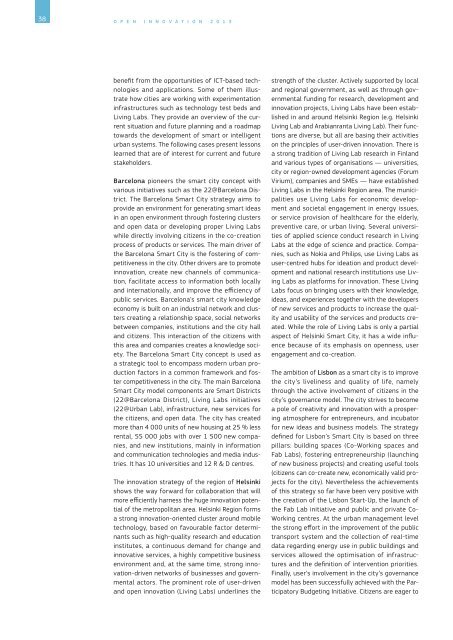Open Innovation 2.0 Yearbook 2013 - European Commission - Europa
Open Innovation 2.0 Yearbook 2013 - European Commission - Europa
Open Innovation 2.0 Yearbook 2013 - European Commission - Europa
You also want an ePaper? Increase the reach of your titles
YUMPU automatically turns print PDFs into web optimized ePapers that Google loves.
38 O P E N I N N O V A T I O N 2 0 1 3<br />
benefit from the opportunities of ICT-based technologies<br />
and applications. Some of them illustrate<br />
how cities are working with experimentation<br />
infrastructures such as technology test beds and<br />
Living Labs. They provide an overview of the current<br />
situation and future planning and a roadmap<br />
towards the development of smart or intelligent<br />
urban systems. The following cases present lessons<br />
learned that are of interest for current and future<br />
stakeholders.<br />
Barcelona pioneers the smart city concept with<br />
various initiatives such as the 22@Barcelona District.<br />
The Barcelona Smart City strategy aims to<br />
provide an environment for generating smart ideas<br />
in an open environment through fostering clusters<br />
and open data or developing proper Living Labs<br />
while directly involving citizens in the co-creation<br />
process of products or services. The main driver of<br />
the Barcelona Smart City is the fostering of competitiveness<br />
in the city. Other drivers are to promote<br />
innovation, create new channels of communication,<br />
facilitate access to information both locally<br />
and internationally, and improve the efficiency of<br />
public services. Barcelona’s smart city knowledge<br />
economy is built on an industrial network and clusters<br />
creating a relationship space, social networks<br />
between companies, institutions and the city hall<br />
and citizens. This interaction of the citizens with<br />
this area and companies creates a knowledge society.<br />
The Barcelona Smart City concept is used as<br />
a strategic tool to encompass modern urban production<br />
factors in a common framework and foster<br />
competitiveness in the city. The main Barcelona<br />
Smart City model components are Smart Districts<br />
(22@Barcelona District), Living Labs initiatives<br />
(22@Urban Lab), infrastructure, new services for<br />
the citizens, and open data. The city has created<br />
more than 4 000 units of new housing at 25 % less<br />
rental, 55 000 jobs with over 1 500 new companies,<br />
and new institutions, mainly in information<br />
and communication technologies and media industries.<br />
It has 10 universities and 12 R & D centres.<br />
The innovation strategy of the region of Helsinki<br />
shows the way forward for collaboration that will<br />
more efficiently harness the huge innovation potential<br />
of the metropolitan area. Helsinki Region forms<br />
a strong innovation-oriented cluster around mobile<br />
technology, based on favourable factor determinants<br />
such as high-quality research and education<br />
institutes, a continuous demand for change and<br />
innovative services, a highly competitive business<br />
environment and, at the same time, strong innovation-driven<br />
networks of businesses and governmental<br />
actors. The prominent role of user-driven<br />
and open innovation (Living Labs) underlines the<br />
strength of the cluster. Actively supported by local<br />
and regional government, as well as through governmental<br />
funding for research, development and<br />
innovation projects, Living Labs have been established<br />
in and around Helsinki Region (e.g. Helsinki<br />
Living Lab and Arabianranta Living Lab). Their functions<br />
are diverse, but all are basing their activities<br />
on the principles of user-driven innovation. There is<br />
a strong tradition of Living Lab research in Finland<br />
and various types of organisations — universities,<br />
city or region-owned development agencies (Forum<br />
Virium), companies and SMEs — have established<br />
Living Labs in the Helsinki Region area. The municipalities<br />
use Living Labs for economic development<br />
and societal engagement in energy issues,<br />
or service provision of healthcare for the elderly,<br />
preventive care, or urban living. Several universities<br />
of applied science conduct research in Living<br />
Labs at the edge of science and practice. Companies,<br />
such as Nokia and Philips, use Living Labs as<br />
user-centred hubs for ideation and product development<br />
and national research institutions use Living<br />
Labs as platforms for innovation. These Living<br />
Labs focus on bringing users with their knowledge,<br />
ideas, and experiences together with the developers<br />
of new services and products to increase the quality<br />
and usability of the services and products created.<br />
While the role of Living Labs is only a partial<br />
aspect of Helsinki Smart City, it has a wide influence<br />
because of its emphasis on openness, user<br />
engagement and co-creation.<br />
The ambition of Lisbon as a smart city is to improve<br />
the city’s liveliness and quality of life, namely<br />
through the active involvement of citizens in the<br />
city’s governance model. The city strives to become<br />
a pole of creativity and innovation with a prospering<br />
atmosphere for entrepreneurs, and incubator<br />
for new ideas and business models. The strategy<br />
defined for Lisbon’s Smart City is based on three<br />
pillars: building spaces (Co-Working spaces and<br />
Fab Labs), fostering entrepreneurship (launching<br />
of new business projects) and creating useful tools<br />
(citizens can co-create new, economically valid projects<br />
for the city). Nevertheless the achievements<br />
of this strategy so far have been very positive with<br />
the creation of the Lisbon Start-Up, the launch of<br />
the Fab Lab initiative and public and private Co-<br />
Working centres. At the urban management level<br />
the strong effort in the improvement of the public<br />
transport system and the collection of real-time<br />
data regarding energy use in public buildings and<br />
services allowed the optimisation of infrastructures<br />
and the definition of intervention priorities.<br />
Finally, user’s involvement in the city’s governance<br />
model has been successfully achieved with the Participatory<br />
Budgeting Initiative. Citizens are eager to
















